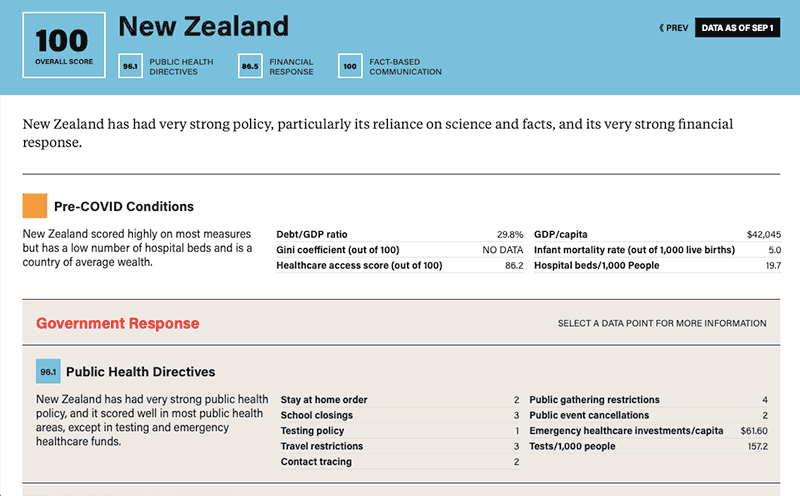Travel and tourism will be changed forever. We asked seven leading thinkers for their predictions.
- 52.8 Public Health
Directives - 66.3 Financial
Response - 100 Fact-Based
Communication
Despite having relatively weak pre-pandemic capacity, swift action and prevention-based messaging from the government helped mitigate spread early on in the crisis.
Pre-COVID Conditions
With the highest infant mortality rate, lowest GDP per capita, and lowest availability of hospital beds in the Index, Ethiopia’s pre-pandemic capacity was very weak.
- Debt/GDP ratio 61%
- GDP/capita $2,702
- Gini coefficient (out of 100) 35
- Infant mortality rate (out of 1,000 live births) 39
- Healthcare access score (out of 100) 44.2
- Hospital beds/1,000 People 1.5
Government Response
Select a data point for more information(Data points represent policy level as of Sep 1.)
Public Health Directives
Ethiopia scores around the median, largely due to its limited testing, minimal emergency healthcare spending, and a weak stay-at-home order.
- Stay at home order 1
- Public gathering restrictions 4
- School closings 3
- Public event cancellations 2
- Testing policy 3
- Emergency healthcare investments/capita $1.42
- Travel restrictions 2
- Tests/1,000 people 7.6
- Contact tracing 1
Financial Response
Ethiopia has offered little income support or debt relief for those affected by COVID-19 and a small stimulus package. However, its relatively low case rate boosts its score.
- Financial stimulus as share of GDP 3.4%
- Income support 0
- Debt forebearance 2
Fact-Based Communication
Ethiopia’s health minster has held regular press briefings, providing fact- and science-based communication to the public with an emphasis on infection prevention.
- Reliance on science/fact based information 0
- Press freedom 0
COVID-19 Status as of Sep 1
Ethiopia has relatively few cases, which could be due to relatively clear messaging from leadership, but moderate testing to date could be obscuring actual case rates.
- Total deaths 809
- Death rate per 100K 7
- Total cases 52,131
- Cases per 100K 454
- Percent of positive tests 7.9
- Change in positivity rates -2.7
| Date | Status | New Cases/1M | |
|---|---|---|---|
| 1 | Jun 19 | Relax quarantine rules for foreign visitors | 1.60 |
Differentiating Factors
- Migrant laborers forced to return home may be fueling outbreak: Over 30,000 migrant laborers have been forced to retun home from Middle Eastern and north African countries, with lack of sanitation in migrant camps increasing the risk of coronvirus spread. Read More
- Public focus on prevention: Ethiopia's large informal sector likely factored into the decision not to impose a harsh lockdown. Instead, the government has focused on prevention and clear messaging around the importance of hygiene and social distancing. Read More
- Community healthcare has been key: The government has invested in community healthcare, to great effect. Health workers have screened an estimated 40 million people with temperature checks. The authorities have additionally created 15,000 beds in isolation centers. Read More
- Development bank aid boosts capacity: In July, Ethiopia received a $165.08 million grant from the African Development Bank to support its health response and ease economic impacts. The government plans to increase testing laboratories and train 45,000 new healthcare workers. Read More
Compared with Other African Countries
-
78Senegal 13,611
Cases 813
Per 1M 284
DeathsSenegal’s COVID-19 policy response has been very strong across the board, buoyed by strong public health directives and a reliance on science and facts.
-
89.5Ghana 44,298
Cases 1,426
Per 1M 276
DeathsGhana scores strongly on the Index, due primarily to its proactive public health policy, strong examples set by leadership, and reliance on facts; while consistently strong, it does have very weak testing, limited emergency healthcare spending, and a weak stimulus.
-
92Kenya 34,201
Cases 636
Per 1M 577
DeathsKenya has a strong overall policy score, although down significantly from January. However, it is consistently scoring well in all areas, particularly its reliance with respect to facts and science on COVID-19.
-
53.1South Africa 627,041
Cases 10,573
Per 1M 14,149
DeathsOverall, South Africa's score is relatively strong with vigorous policy implementation—particularly with respect to lockdowns—offset by its relatively meager financial response.
Further Reading From Foreign Policy
Be the source of actionable insight.
Select one of the subscription options below to read the full Covid-19 Global Response Index. Unlock even more global intelligence with a subscription to FP Insider.
Already an FP Insider? Log In
Looking for group access? Contact us directly

Statistics and government response factors available on each country profile include:
Pre-COVID Conditions:
- Debt to GDP ratio
- Infant mortality rates
- Hospital beds per 1,000 people
- Gini coefficients measuring inequality
- Health access and quality
COVID-19 Public Health Directives:
- Stay-at home orders
- School-closing policy
- Public-gathering restrictions
- Cancellation of public events
- Testing policy and rates per 1,000 people
- Emergency healthcare spending per capita
- Travel restrictions
- Contact tracing
COVID-19 Financial Response:
- Stimulus package as a share of GDP
- Income support
- Debt-forbearance
Public Communications:
- Instances of misinformation by leadership
- Limitations on press freedom, censorship
Current/Historic In-Country COVID-19 Status:
- Death rates per 1 million
- Case rates per 1 million


